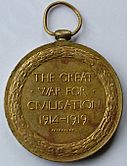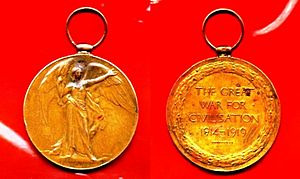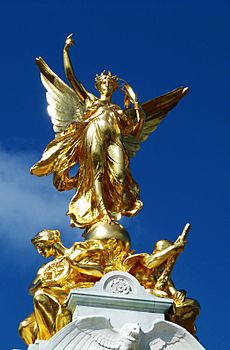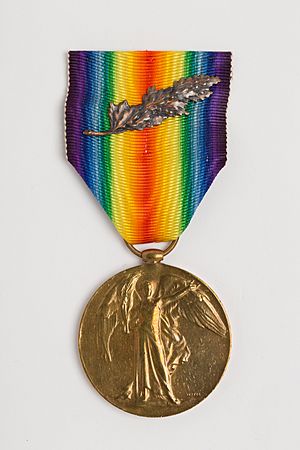Victory Medal (United Kingdom) facts for kids
Quick facts for kids Victory Medal 1914–19 |
|
|---|---|
 
Obverse and reverse of the medal
|
|
| Awarded for | Bronze disk, 36mm diameter. |
| Presented by | United Kingdom / British Empire |
The Victory Medal is a special award given after the First World War. It was also known as the Inter-Allied Victory Medal. This medal was given to soldiers from the United Kingdom and countries that were part of the British Empire.
Many countries that fought together in the war decided to create a similar medal. In March 1919, a group of allied nations agreed on a common design. Each country would make its own version of the "Victory Medal." But they all had some things in common. For example, they all featured a winged figure of victory on the front. They also used the same rainbow-colored ribbon. In the end, fourteen countries gave out this medal.
Contents
Who Earned the Victory Medal?
The Victory Medal (United Kingdom) was given to many people. This included those who had already received the 1914 Star or the 1914–15 Star. Most people who earned the British War Medal also got this one. It was never given as the only medal.
To get the medal, people needed to serve in the armed forces. This included forces from the United Kingdom or the British Empire. Some recognized volunteer groups also qualified. They had to have served in a war zone between August 5, 1914, and November 11, 1918.
Serving only at home did not count. However, members of the Royal Air Force (RAF) in the UK who fought the enemy in the air did qualify. This also included those who flew new planes to France. Women could also earn this medal. They served in nursing and other support roles in war zones.
The medal was also given for clearing mines in the North Sea. This was done between November 11, 1918, and November 30, 1919. People who took part in the Allied intervention in the Russian Civil War until July 1, 1920, also qualified.
What Does the Medal Look Like?
- The medal is made of bronze and is round. It is about 36 millimeters (1.4 inches) across. It was designed by William McMillan.
- The front side, called the "obverse," shows a winged figure. This figure is "Victory" or "Victoria". She has her left arm out and holds a palm branch in her right hand. This looks like the statue on the Queen Victoria Memorial in London.
- The back side, called the "reverse," has the words "THE GREAT / WAR FOR / CIVILISATION / 1914–1919". These words are in four lines. A laurel wreath surrounds them.
- The ribbon is about 39 millimeters (1.5 inches) wide. It has a special wavy pattern called "watered". Its colors go from violet to a red stripe in the middle. The ribbon connects to the medal with a ring.
- The medal's edge shows the recipient's name, rank, service number, and unit. For Army officers, the name of their regiment was not included.
- If a person was mentioned in official reports for brave actions, they got a bronze oak leaf spray. This was worn on the medal's ribbon. A smaller version was used on the ribbon bar when the full medal was not worn.
Fun Nicknames for the Medals
Soldiers gave funny nicknames to the three main medals from the First World War. These were the 1914 Star (or 1914–15 Star), the British War Medal, and the Victory Medal.
They called them Pip, Squeak and Wilfred. These were popular cartoon characters from that time: a dog, a penguin, and a rabbit.
- Pip was either of the two Stars.
- Squeak was the British War Medal.
- Wilfred was the Victory Medal.
If someone only had the British War Medal and the Victory Medal, they called them Mutt and Jeff. These were also famous newspaper comic strip characters.
Other Countries' Victory Medals
In March 1919, a committee in Paris suggested that all allied countries should have a similar medal. This would mean countries wouldn't need to trade their own medals. Each allied country designed its own version. But they all followed certain rules.
The medal had to be bronze and 36 mm wide. It needed a winged figure of victory on the front. It also had to have a common message on the back. And it had to hang from a double rainbow ribbon. Japan and Siam (now Thailand) changed the winged victory symbol. This was because a winged victory symbol did not fit their culture.
Here are some of the countries that awarded their own versions of the Victory Medal:
| Country | Number issued |
|---|---|
| Belgium | 300,000–350,000 |
| Brazil | approximately 2,500 |
| Cuba | 6,000–7,000 |
| Czechoslovakia | approximately 89,500 |
| France | approximately 2,000,000 |
| Greece | approximately 200,000 |
| Italy | approximately 2,000,000 |
| Japan | approximately 700,000 |
| Portugal | approximately 100,000 |
| Romania | approximately 300,000 |
| Siam (Thailand) | approximately 1,500 |
| South Africa | approximately 75,000 |
| United Kingdom | Circa 5,725,000 |
| United States | approximately 2,500,000 |
See Also
- British campaign medals
- Australian campaign medals
- New Zealand campaign medals




